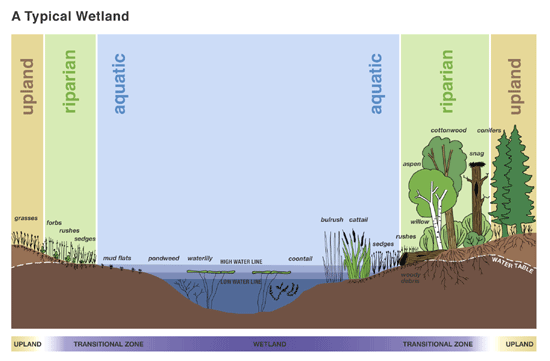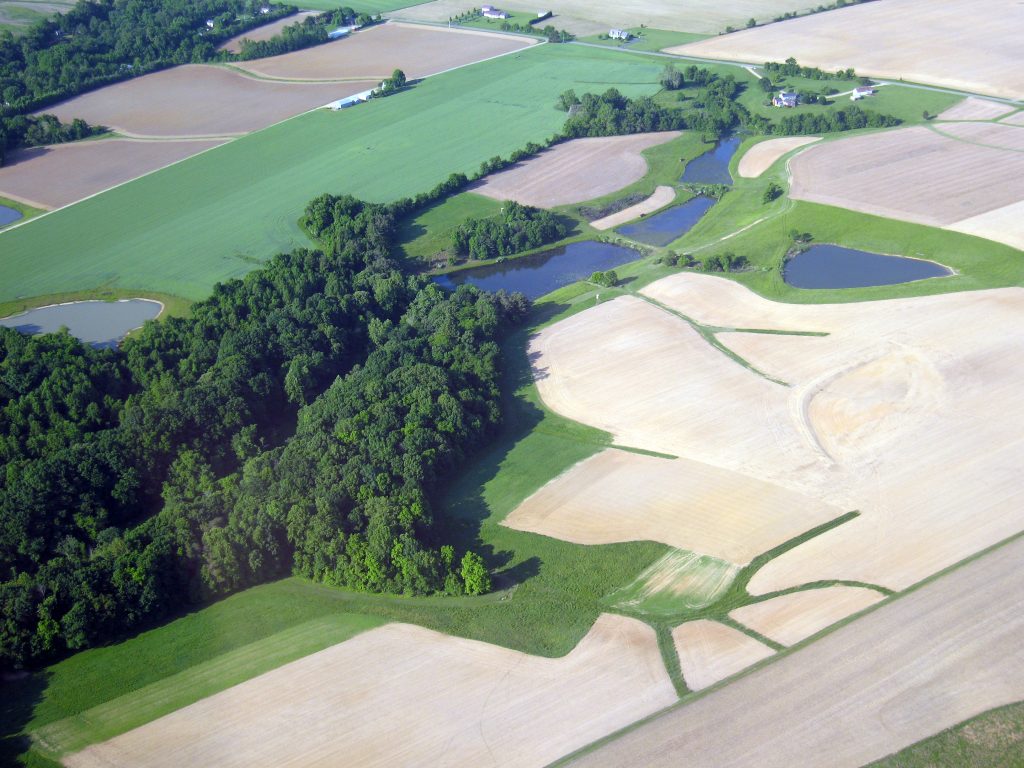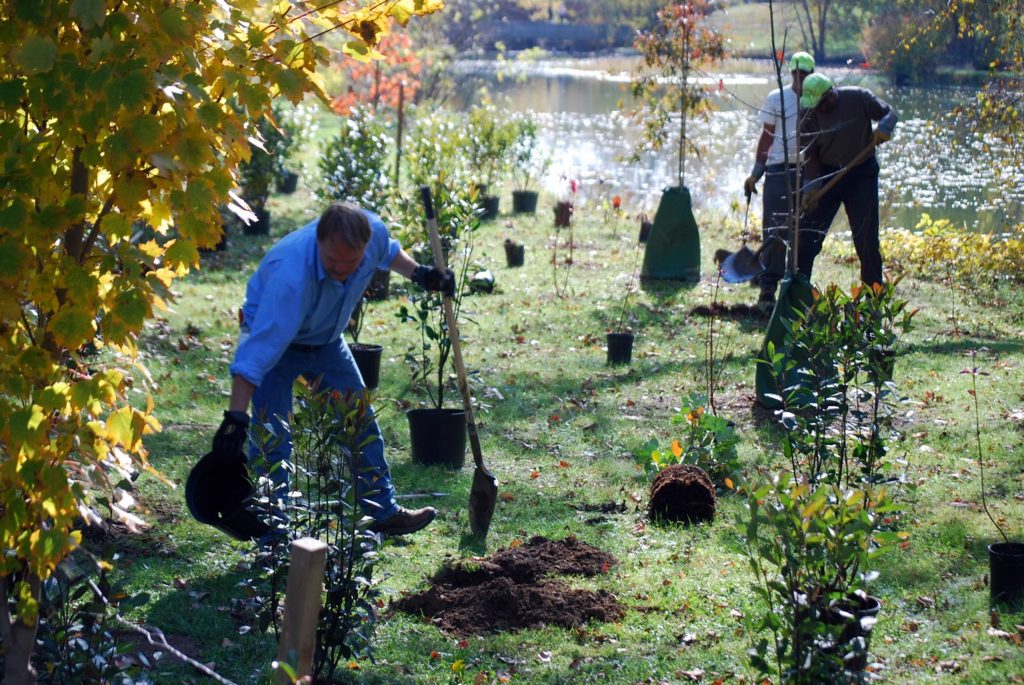
Facebook Twitter Instagram YouTube
Written on: December 10th, 2019 in Wetland Restoration
By Clare Sevcik, DNREC’s Nonpoint Source Program

Riparian buffers are planted areas specifically next to waterways, such as streams, ponds, wetlands, and rivers. These areas are extremely important to keeping our waters healthy. They do so by filtering and trapping nutrients and sediment out of waters before they enter our local waterways.
Different types of plants can be found in buffers, ranging from grasses to mature trees. The type of plants present in the buffer has an effect on how it may function.
Usually, riparian buffers are classified into two types, grass or forest. As the name suggests, grass buffers are dominated by grasses. Grasses are tremendously effective in slowing down the flow of water, but are still not as efficient as our next buffer type in improving water quality and quantity.
Forest buffers are dominated by larger plants, such as shrubs and trees. Planted forested buffers are usually made up of a variety of species that will grow to different heights to recreate a natural forest. These plants are bigger, therefore hold onto more water and have more water processing ability. One thing to note is that the type and placement of each tree requires a lot of forethought and planning to make sure the buffer is successful.

Buffers serve a number of important roles in the ecosystem. First, they are a waterway’s first defense against runoff. As rainwater flows across the land, it picks up various pollutants. Buffers help by slowing down this water, giving plants a chance to remove pollutants, such as sediment and nutrients, and allowing the water to seep into the ground. Excess nutrients in waterways can be a huge issue because it can cause algae to bloom and wreak havoc on the water quality in a process called eutrophication.
In a heavy rain event, unprotected and unsecured banks can erode due to flooding and runoff. Both types of vegetated buffers help maintain shorelines by stabilizing the banks and holding together the sediment. Forest buffers especially boast large root systems that can hold sediment extremely well once the plants are established. These root systems are able to hold onto the sediment and prevent the flooding from carrying it further downstream.
Lastly, forest buffers are also important to support local wildlife and a healthy ecosystem. Most waterways benefit from shade from established trees with a good sized canopy along the bank. This shade helps to regulate the water temperature, preventing the water from warming excessively, as warmer waters may encourage large algal blooms and cause unnecessary stress for fish and other aquatic organisms. The root systems from these trees can also provide nursery habitat and shelter for animals.
Riparian forest buffers provide more benefits and protection for waterways than grass buffers, so many states are looking to implement these as best management practices (BMPs) to improve water quality. For example, about a third of Delaware is located in the Chesapeake Bay Watershed. Therefore, Delawareans in that 1/3 of the state have an impact on the Chesapeake Bay. Installing riparian buffers in these areas can help Delaware meet its goals for reducing pollution to the Bay, which is a beautiful and vital resource in the Mid-Atlantic region.

Delaware is among six Chesapeake Bay Watershed states – along with Maryland, Virginia, West Virginia, Pennsylvania, and New York – and the District of Columbia committed to a federal-state initiative to develop a pollution “diet” that will help restore the water quality of the Chesapeake Bay and its tidal waters by 2025.
All of these states are working to improve the Bay’s waters by implementing projects, or Best Management Practices (BMPs), throughout the watershed. Delaware’s most recent, and final, strategy for implementing BMPs can be found in Delaware’s Chesapeake Bay Phase III Watershed Implementation Plan (WIP). In addition to implementing BMPs, Delaware has committed to a wide array of goals and outcomes that were outlined in the 2014 Chesapeake Bay Watershed Agreement.
Because Delaware signed onto the 2014 Chesapeake Bay Watershed Agreement, the State has been specifically designated federal funding to help meet Chesapeake Bay goals. These funds are categorized into two grants, the Chesapeake Bay Implementation Grant (CBIG) and the Chesapeake Bay Regulatory and Accountability Program (CBRAP).
The CBIG focuses on funding projects consistent with the 2014 Chesapeake Bay Watershed Agreement goals and outcomes: sustainable fisheries, vital habitats, water quality, toxic contaminants, healthy watersheds, stewardship, land conservation, public access, environmental literacy, and climate resiliency. This grant is awarded based on Request for Proposal submissions to DNREC’s Nonpoint Source Program.
The CBRAP grant focuses on implementing and expanding their jurisdictions’ regulatory, accountability, assessment, compliance, and enforcement capabilities in support of reducing nitrogen, phosphorus, and sediment loads delivered to the Bay to meet the Water Quality Goal of the 2014 Chesapeake Bay Watershed Agreement and the Bay TMDL.
Different federal funding sources are also available to cost-share other BMPs. In particular, the Conservation Reserve Enhancement Program (CREP) focuses on the agricultural sector, and offers incentive payments to landowners in the Chesapeake Bay Watershed portion of Delaware to implement BMPs. There is a particular focus on creating new or improving existing forested buffers on their properties.
If you are interested in learning more about buffers and the grant programs please contact Brittany.Sturgis@delaware.gov (CBIG), Sara.Wozniak@delaware.gov (CBRAP), or Patti.Webb@delaware.gov (CREP).